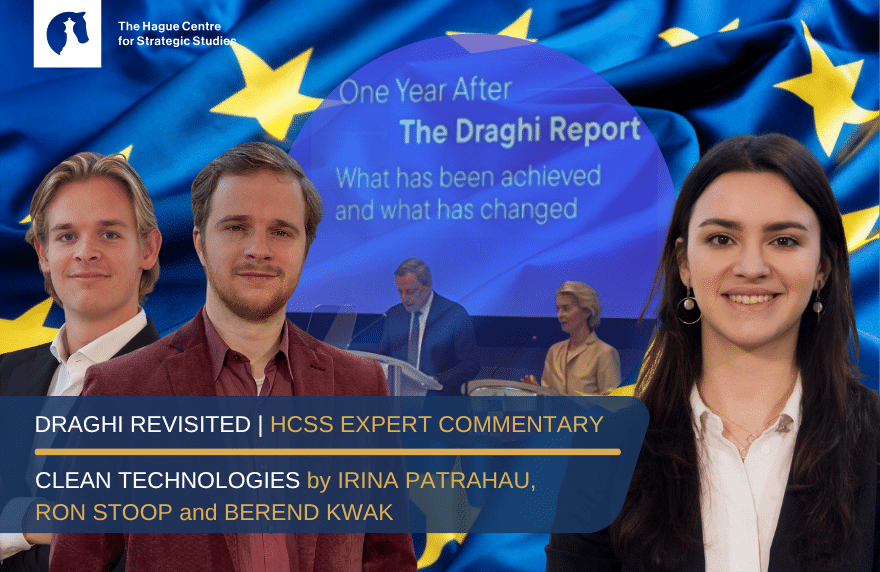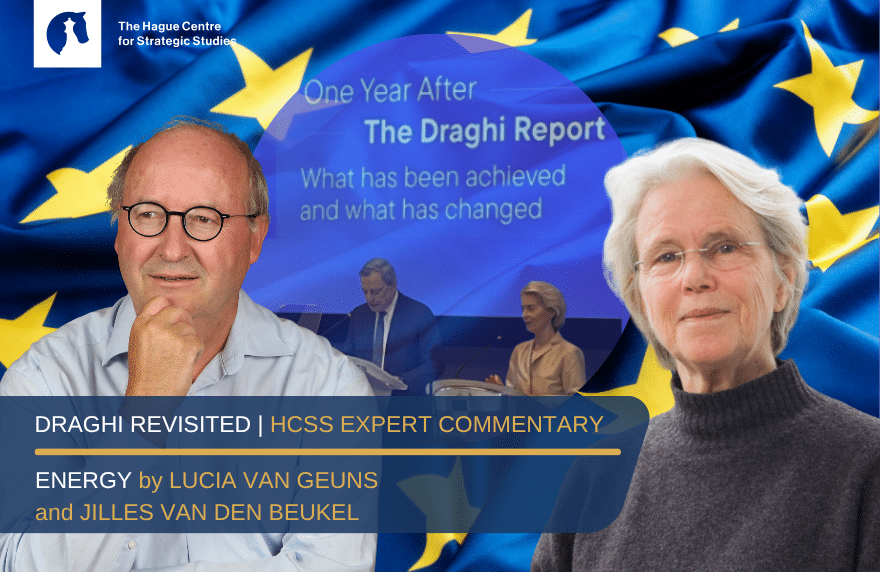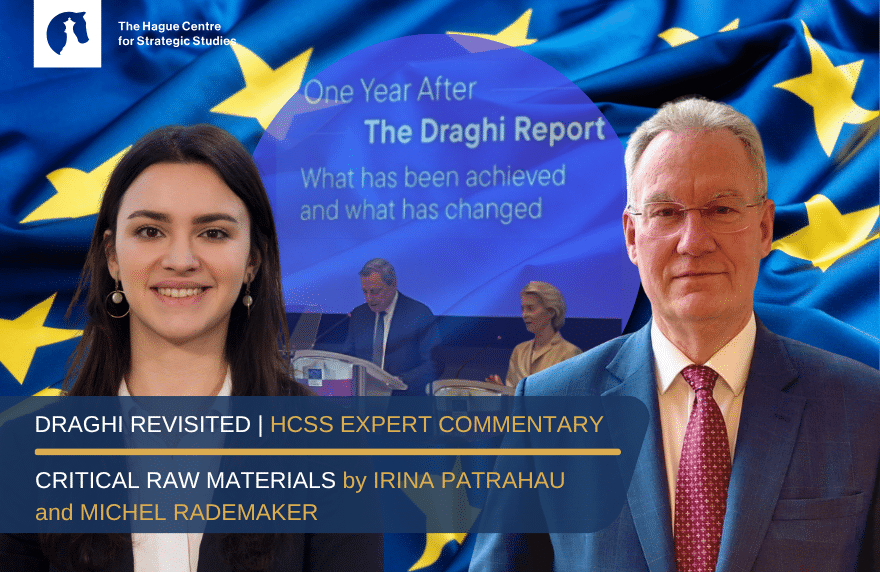One year after Mario Draghi’s landmark report on Europe’s economic future, HCSS launches the second edition of its Draghi Report Series.
Despite political attention, Europe still struggles with dependencies in defence, raw materials, cleantech, and digital domains. Global tensions with both China and the US are mounting, and Europe’s trade model faces unprecedented pressure. Progress has been uneven and often too slow due to coordination, financing and other internal barriers.
Last year, Ron Stoop and Berend Kwak examined the long-term implications of Draghi’s recommendations in a series of interviews with our experts. Now, they return to assess how far Europe has come in addressing his urgent call to secure industrial, technological and economic sovereignty, with HCSS analysts revisiting Draghi’s warnings sector by sector.
For the sixth article of our Draghi Revisited series, strategic analysts Irina Patrahau, Ron Stoop and Berend Kwak examine whether Europe’s clean tech ambitions are turning into tangible results. How far has the EU come in strengthening its clean tech competitiveness — and how far does it still has to go?
Since the publication of the Draghi Report, what concrete steps have been taken at the EU and member state level in the clean tech sector, and how effective have they been so far?
Irina Patrahau: In the clean tech sector, the EU has been moving from plans and ambitions to more concrete action. The Net Zero Industry Act established faster permitting and support for strategic projects across net-zero technologies. The Clean Industrial Deal introduced earlier this year mobilised over €100 billion and expanded measures on skills and education. The Innovation Fund has already channelled more than €12 billion into about 200 large-scale projects.
Early impacts are visible, but effectiveness remains uneven. Regulatory bottlenecks, private capital uncertainty, and a slow transition from planning to scaled deployment mean that most benefits will materialise towards 2030. The rapid movements of the US, China and India, which are taking an integrated supply chain approach by design, is also a risk for the future competitiveness and supply security of the EU clean tech industry.
Tenders for clean tech deployment across all member states should be created to support European industrial development. The EU’s demand for clean tech to achieve net zero in the coming decades will be significant and can boost internal production, but these policy goals must be aligned between countries and within national governments. Don’t punish those that are not buying fully European, but reward those that do.
Ron Stoop: The period after the Draghi report saw a few key developments. First of all, the further implementation of the Net Zero Industry Act (NZIA) regulation: the NZIA has set future targets for clean technology production, such as 40% of domestic clean technology production by 2030, and it outlined the eligibility criteria for ‘net-zero’ project. 2025 saw further implementation of this regulation into workable policy.
Secondly, the Competitiveness Compass was enacted in 2025. This strategic document assessed Europe’s position in key clean tech value chains by benchmarking industrial strengths and innovation capacity against global competitors. For example, the Compass showed how high energy prices and slow permitting make it harder for Europe to expand solar panel and battery production compared to other continents such as North America and Asia. After that, the Clean Industrial Deal, a policy and investment framework, was announced in February 2025 to support the EU’s industrial decarbonisation strategy and mobilise over €100 billion in support. These investments should support clean energy, faster permitting, more renewable Power Purchasing Agreements (PPAs) and additional demand for low-carbon products via public procurement, as well as introducing a new state-aid framework and the inception of an Industrial Decarbonisation Bank.
Overall, these initiatives have not yet resulted in a renaissance of clean technology manufacturing in the EU. Europe remains highly dependent on foreign countries for clean technologies. Of course, one should account for lags between policy and their subsequent effects. But the market logic of China dominating most clean technologies has not been stopped or reversed. There is still a long road ahead for the EU.
Berend Kwak: The Net-Zero Industry Act (NZIA) was mentioned in Draghi’s report and now moved into implementation. In June 2025, the Commission adopted rules for defining “strategic projects”, which are granted priority access to permits and financing. This is a structural step forward. However lack of grid capacity remains a large bottleneck for the clean technology industry. This should be the new main priority to incentivise clean technology adoption. The NZIA also announced the adoption of more non-price criteria for procurement of clean technologies, designed to redirect European investment to domestic components for competitiveness and security reasons and increase resilience. Countries like India have been working with such non-financial criteria and boosted their clean tech industries. Its good that Europe has frameworks, now it needs to work on realisation.
Where do the biggest gaps lie between political ambition and practical implementation, and why do they exist?
Irina Patrahau: The biggest gaps lie in financing, industrial scaling and national rather than European actions. Efforts to scale domestic manufacturing of batteries, electrolysers, and renewables lag behind targets. This is partly due to the slow offtake in consumers despite significant EU ambitions, regulations and directives (Net Zero Industrial Act, RePower EU, Renewable Energy Directive). Large EU funds have been made available, but private capital is still hesitant given high upfront costs, long payback periods, and policy uncertainty. At the same time, grid and infrastructure expansion is not keeping pace with electrification, hydrogen and e-fuel ambitions. These gaps persist because the EU is strong at setting ambitious targets but weaker at execution, constrained by complex governance and difficulties to create a European rather than national approach to implementation.
Ron Stoop: The EU has rolled out major clean-tech frameworks like the Net-Zero Industry Act (NZIA) and the Clean Industrial Deal, but results have not kept up with ambition. The 2030 goal of producing 40% of net-zero technologies within Europe is unlikely to be met, while capital mobilisation, permitting speed, and industrial coordination remain weak. Much of the promised €100 billion in cleantech investment has yet to translate into actual projects. The struggles of Northvolt, once the EU’s promised battery champion, reveal Europe’s failure to think strategically and plan for long-term industrial competitiveness. In contrast, countries such as India are advancing clean-tech manufacturing through clear regulatory tools such as domestic content rules and simple and clear policy incentives. Meanwhile China continues to expand its dominance: its turbine makers are winning bids not only in Europe (for instance, with Luxcara in Germany, which was later reversed) but also in third markets like the Middle East and Latin America. Europe now faces the risk of becoming a clean-tech importer rather than a producer. To counter this trend, the EU should prioritise increasing its investment capacity and coordinating cleantech policy across Member States.
Berend Kwak: Europe’s power networks have become the new choke point. Projects can now be approved faster, but connecting them to the grid still takes up most of the implementation time. Clean tech projects (especially hydrogen) still tend to not reach FID for a lack of demand and development capacity. The solar industry faces problems too: 2025 marked the first contraction in EU solar manufacturing in a decade (5% measured by employment). As we have seen before, Chinese overcapacity and falling panel prices have wiped out several European manufacturers well before Europe created policy measures to tackle these issues. It seems like Europe’s financial and regulatory frameworks remain too slow to translate the stated ambitions into economically competitive reality, as the competitive landscape for companies moves faster than Brussels can keep up. This echo’s Draghi’s original diagnosis that while Europe has strategic clarity, it lacks operational speed and agility.
Looking ahead, what should be the EU’s top two or three priorities to stay competitive, and where might it make sense to scale back?
Irina Patrahau: The EU should focus on developing a few supply chains with potential for leadership, like wind, electrolysers and batteries. Matching (emerging) supply of materials and components like permanent magnets with demand across Europe can boost decarbonization goals and create a stronger European industrial base. Within each sector, the EU can choose to focus on activities where it can become a technological leader – latest generation electrolysers or the nickel manganese and cobalt oxide (NMC) lithium-ion battery chemistry, for which the EU is also building CRM capabilities. Identifying these high potential sectors is essential, and it will also inform the decision of which sectors to scale back on.
Ron Stoop: Despite Draghi’s view that solar manufacturing should perhaps not be prioritised in Europe, I believe we actually should invest in at least a solar manufacturing capacity base. While China dominates production, global demand for solar power is set to soar. It is becoming increasingly evident that solar will become one of the largest modes of electricity generation. Abandoning solar manufacturing capacity completely would mean giving up future competitiveness in a technology central to the energy transition. The EU should rebuild parts of its solar industry around innovative and circular technologies, but also rebuild general wafer/ingot/cell/module capacity within its borders. Public procurement rules and local content requirements could play a role in this.
Moreover, onshore wind should be re-prioritised. It remains a good match with solar in terms of output patterns, and infrastructure costs are significantly lower than with offshore wind. Unfortunately, permitting and local opposition have slowed the development of the onshore wind industry. In the last years, offshore wind has been considered one of the key strategies for Northwestern European electricity generation (and by extension, the whole EU grid). However, due to high building and infrastructure costs, many building ambitions have been scaled back. Levelised Cost of Electricity (LCOE) estimates clearly show onshore wind being cheaper than offshore. Communication around the necessity for local, close-to-offtake onshore wind should be clear and decisive.
The EU must also move faster on next-generation batteries, particularly sodium-ion. These battery types not only offer lower future costs, but also more secure supply chains (partly depending on the exact battery chemistry) due to the higher availability of some of these materials. Also, these battery manufacturing initiatives should be integrated into the European electric vehicle supply chain.
Berend Kwak: A first priority should be to make NZIA implementation even more tangible, for example through a stronger combination of fast-track permitting, a guarantee of grid access, and attractive financial support for the EU’s “strategic projects.” This could be done through instruments like InvestEU and the European Investment Bank (EIB) combined with coherent policy drivers across the member states.
Second, Europe should focus on sectors where it has capabilities to succeed, such as offshore wind or grid technology. Concentrating funding and regulation in these areas will generate more competitive power than trying to revive or reshore sectors like solar. It hence comes down to a sufficient combination of the essential incentives. As mentioned in our commentary last year, this will likely force Europe to choose industries and let go of others. Another important priority should be securing supply of the essential raw materials needed to expand on these industries, which are sourced outside of Europe, as discussed in our commentary on critical raw materials (CRM).
If we meet again in a year, what single measurable outcome would convince you that Europe is on the right track in this sector?
Irina Patrahau: I hope to see more coherent tendering procedures for securely and sustainably produced clean tech across European countries.
Ron Stoop: If the EU can scale up its production capacity of LFP and Sodium-Ion battery manufacturing capacity, it would show that the EU can still compete in the cleantech game, whilst also rebuilding the European Industry around the sectors of the future.
Berend Kwak: A hard indicator showing that Europe is finally managing to realise its plans would be an increase in “strategic projects” under the NZIA officially designated and under construction. This would prove that the EU is turning policy into concrete sites and domestic productivity. Rather than measuring e.g. the output of clean tech power generation, this would show that the EU is succeeding in creating conditions for investment and implementation. In other words, not only expanding its capacity but nurturing and growing its industrial base across the Union.








